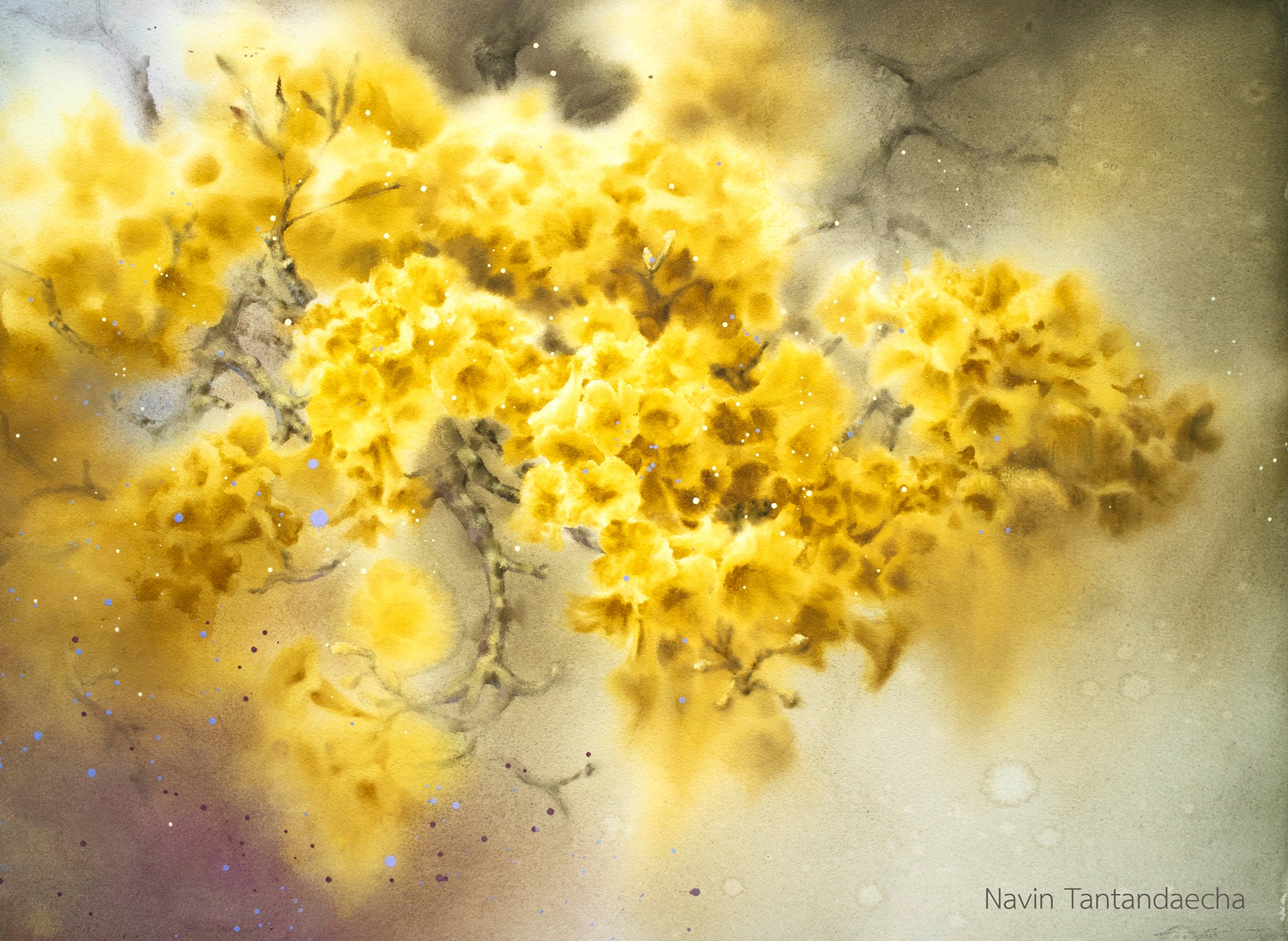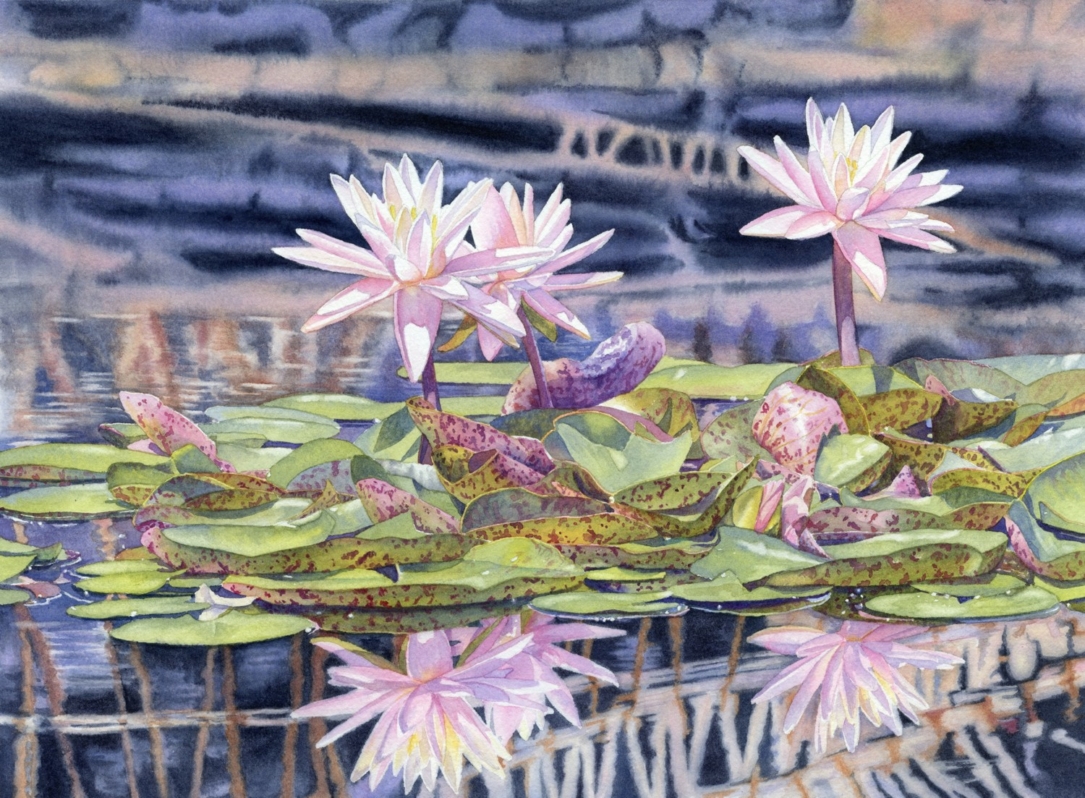以下是 Navin Tantanadaecha 的問答
為什麼要創作藝術?
身為人,我熱衷於探索生命的成長。藝術為我提供了一個空間,讓我可以靜心觀察內在和外在發展的過程。透過我作為教育工作者和藝術家的經歷,我逐漸理解藝術是一種通用語言,也是一種無限的自我表達方式。此外,藝術始終是誠實的,反映了我們真實的自我;它是一種交流的形式。
水彩畫以其柔和、流動、不確定、透明等特質,始終反映我每個生命階段的狀態,讓我能夠連結並表達自己真實的聲音。對我來說,水彩畫是研究生命成長的重要地點。
你畫畫多久了?
我接觸水彩畫大約16年了。 2009年,我第一次接觸水彩畫,當時它是大學的必修課,但由於難以掌控這個媒介,我對它印象並不好。於是,我決定探索其他媒材。三年後,在我的最後一學期,我遇到了Siriratana Sriseung,她成為了我創作水彩畫的最大靈感來源。她教我擁抱它的不確定性,這讓我的視角從試圖控制轉變為接受並運用它。這也是我職業生涯的開始。
你受過正規的藝術訓練嗎?
是的。我的正式藝術訓練可以分為兩個階段。第一階段,我透過補習班學習繪畫基礎,為申請藝術大學做準備。之後,在大學學習藝術教育期間,我拓展了版畫、繪畫、雕塑和設計等藝術教學的基本基礎。
您是一位職業藝術家還是業餘愛好者?
我目前是一位專業的教學藝術家。然而,我最初只是出於業餘愛好,在曼谷的鋼筋水泥叢林中捕捉花朵的美。隨著時間的推移,我的創作視角逐漸擴展至抽象藝術,並由此探索藝術與生活的意義。
從業餘愛好者到職業藝術家的轉變是循序漸進的。我的持續創作和展覽都是隨著時間的推移自然而然地發展起來的。
您從誰和/或什麼事物中尋求靈感?
在我的職業生涯的每個階段,都有許多藝術家給我啟發。起初,Siriratana Sriseung 教會我不確定性是水彩畫的精髓,讓我的視角從掌控媒材轉向擁抱其不可預測的本質。另一位對我影響深遠的藝術家是 Adisorn Pornsirikarn,他幫助我欣賞水彩畫的新鮮感和流動性,即使在作品完成後也是如此。 Praiwan Chairat 也用他的名言「堅持做下去,不要放棄」激勵了我,這句名言在挑戰中給了我力量。
在我的藝術發展歷程中,我受到了埃娃·卡賓斯卡 (Ewa Karpinska)、約瑟夫·茲布克維奇 (Joseph Zbukvic)、讓·海恩斯 (Jean Haines)、錢忠偉 (Chien Chung-Wei) 和永山裕子 (Yuko Nagayama) 的啟發。他們非凡的畫作,以及透過書籍、媒體和演示分享的知識,成為了我至今仍在課堂上參考的寶貴資源。
最近,我一直在用壓克力顏料創作,以我透過水彩畫發展出的視角為基礎。格哈德·里希特是我的榜樣,他透過藝術表達自己的個人經驗。樸棲甫也深受韓國「單色畫」(Dansaekhwa)藝術運動的啟發——這種運動根植於精神性和抽象性。他對冥想式的簡約的欣賞教會我探索內在自我,並更加深刻地珍惜生命。
您繪畫時會聽什麼類型的音樂?
這取決於創作主題和創作階段。如果我處於關鍵階段,例如塗第一層水彩(具象畫需要控制水彩的流動性,抽象畫需要噴灑),我更喜歡保持安靜,因為這個階段需要純粹的專注。
當我在繪畫時,我更喜歡平靜而溫暖的音樂,例如爵士樂,憂鬱的曲調,諾拉瓊斯,或柔和而緩慢的旋律。
您有導師嗎?
在我的水彩畫之路上,很遺憾我沒有正式的導師,因為我是自學成才。不過,在我剛開始學習繪畫的時候,Monchai Pittayawaraporn 是我的導師。他不僅教會了我繪畫知識和技巧,也給了我成長的機會。
你每天都畫畫嗎?
我不能每天都畫畫,因為我還需要兼顧其他事情。然而,我後悔年輕時的懶惰,所以自從我開始我的水彩畫生涯以來,我已經堅持畫了15年。我承諾自己每週至少畫3-4天,承諾不等待空閒時間,也不找藉口。
您一次畫一幅畫還是同時畫幾幅畫?
我一次只創作一件作品。作為一名深思熟慮且專注的實踐者,專注於一件作品讓我能夠在創作下一件作品之前進行回顧、改進和深刻反思。
您是否先創作了一個概念作品?
並非總是如此。有時我會嘗試不同的色調,當我看到與這些顏色相符的花朵、感覺或物體時,作品就從這裡開始。其他時候,我會從一種特定的感覺開始,然後努力透過媒介將其視覺化。
我相信靈活性和對任何可能發生的情況的準備是關鍵。
您喜歡在工作室裡畫畫還是在戶外畫畫?
我更喜歡在工作室裡作畫,因為這裡能提供我所需的寧靜,讓我聆聽內心的聲音,而這深深影響著我的藝術創作。然而,旅行時,我喜歡在戶外作畫,捕捉一個地方的靈魂。
您使用多少核心色?
我以前很依賴核心色,但現在很少固守,因為我喜歡探索各種不同特性的顏色。很多時候,我曾經不喜歡的顏色最終卻很適合某幅畫。
我比較常用的一些顏色包括:法國群青、生赭石、德國綠色生赭石、石墨灰、正品古銅輝石、正品藍晶石、燈黑和鈦白。
管子、鍋子、還是棍子?
我更喜歡管狀的,因為它們可以容納各種濃度的飲料,例如茶、牛奶或黃油
每週透過 Zoom 或 Facebook 線上加入我們, 與 John Cogley 的近距離私人對話 (丹尼爾史密斯所有者兼首席執行官)以及來自世界各地的客座藝術家。每週四(太平洋時間下午 2:00),John 和我們的一些 品牌大使 突出顯示一組顏色並回答您的問題。每週五(太平洋時間上午 10:30),客座藝術家都會分享他們最喜歡的技巧和技術的演示。 點擊此處查看下週的 Zoom 鏈接.







